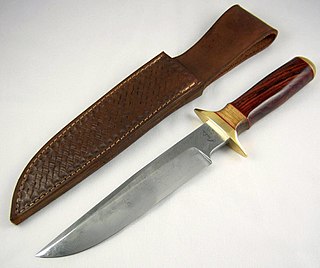
A knife is a tool or weapon with a cutting edge or blade, usually attached to a handle or hilt. One of the earliest tools used by humanity, knives appeared at least 2.5 million years ago, as evidenced by the Oldowan tools. Originally made of wood, bone, and stone, over the centuries, in step with improvements in both metallurgy and manufacturing, knife blades have been made from copper, bronze, iron, steel, ceramic, and titanium. Most modern knives have either fixed or folding blades; blade patterns and styles vary by maker and country of origin.
A puukko is a small traditional Finnish general purpose belt knife with a single curved cutting edge, solid hidden tang, and usually, a flat spine. Military models of puukko were popular in the Russian criminal underworld under the name "Finnish knife" or finka since the 20th century. The modified version were among the models on which the Soviet military knife NR-40 was based and which was informally called "finka".
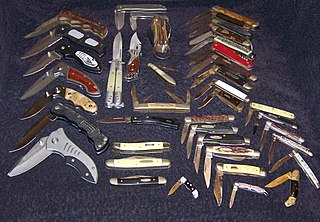
A pocketknife is a knife with one or more blades that fold into the handle. They are also known as jackknives, folding knives, EDC knife, or may be referred to as a penknife, though a penknife may also be a specific kind of pocketknife. A typical blade length is 5 to 15 centimetres.

The SOG Knife was designed for, and issued to, covert Studies and Observations Group personnel during the Vietnam War. It was unmarked and supposedly untraceable to country of origin or manufacture in order to maintain plausible deniability of covert operators in the event of their death or capture.

Ernest R. Emerson is an American custom knifemaker, martial artist, and edged-weapons expert. Originally an engineer and machinist in the aerospace industry, Emerson became a knifemaker by producing knives for a martial arts class and making art knives early in his knifemaking career. In the 1980s he became better known for his combat knives and popularizing a style of knife known as the Tactical-folder.
A knife fight is a violent physical confrontation between two or more combatants in which one or more participants are armed with a knife. A knife fight is defined by the presence of a knife as a weapon and the violent intent of the combatants to kill or incapacitate each other; the participants may be completely untrained, self-taught, or trained in one or more formal or informal systems of knife fighting. Knife fights may involve the use of any type of knife, though certain knives, termed fighting knives, are purposely designed for such confrontations – the dagger being just one example.
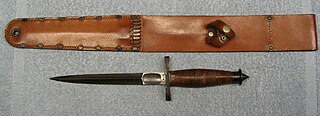
The V-42 stiletto was a fighting knife issued during World War II to the First Special Service Force, a joint American/Canadian commando unit.
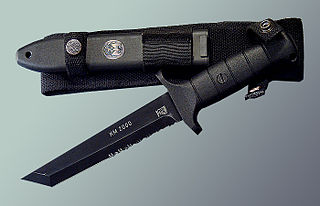
The KM2000 is the standard combat knife of the German Bundeswehr, mostly used by the German Army. The knife is manufactured in Germany by the Eickhorn-Solingen company.
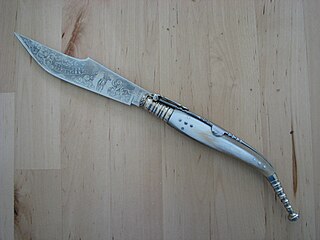
The navaja is a traditional Spanish folding-blade fighting and utility knife.
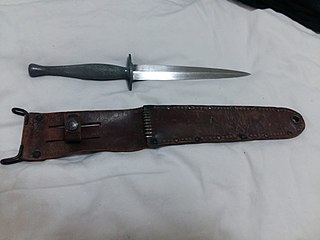
The United States Marine Raider stiletto was issued to the Marine Raiders and 1st Canadian Parachute Battalion during World War II.

The CQC-6 or Viper Six is a handmade tactical folding knife with a tantō blade manufactured by knifemaker Ernest Emerson. Although initially reported as the sixth design in an evolution of fighting knives and the first model in the lineup of Emerson's Specwar Custom Knives, Emerson later revealed that the knife was named for SEAL Team Six. It has a chisel-ground blade of ATS-34 or 154CM stainless steel and a handle made of titanium and linen micarta. The CQC-6 is credited as the knife that popularized the concept of the tactical folding knife.

The M3 trench knife or M3 fighting knife was an American military combat knife first issued in March 1943. The M3 was originally designated for issue to soldiers, not otherwise equipped with a bayonet. However, it was particularly designed for use by forces in need of a close combat knife, such as Airborne Units and Army Rangers, so these units received priority for the M3 at the start of production. As more M3 knives became available in 1943 and 1944, the knife was issued to other soldiers such as Army Air Corps crewmen and soldiers not otherwise equipped with a bayonet, including soldiers issued the M1 carbine or a submachine gun such as the M3 submachine gun "grease gun".
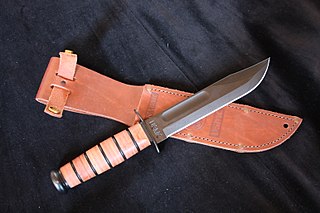
Ka-Bar is the contemporary popular name for the combat knife first adopted by the United States Marine Corps in November 1942 as the 1219C2 combat knife, and subsequently adopted by the United States Navy as the U.S. Navy utility knife, Mark 2. Ka-Bar is the name of a related knife manufacturing company, Ka-Bar Knives., Inc., of Olean, New York, a subsidiary of the Cutco Corporation.

The Glock knife is a military field knife product line designed and produced by Glock Ges.m.b.H., located in Deutsch-Wagram, Austria. It can also be used as a bayonet, by engaging a socket in the pommel into a bayonet adapter that can be fitted to the Steyr AUG rifle.

A fighting knife has a blade designed to most effectively inflict injury in close-quarters physical confrontations. The combat knife and the trench knife are examples of military fighting knives.

Szabla wz. 34 was the last service sword issued to the Polish cavalry and other mounted units of the Polish Army. One of the finest weapons in a long list of Polish sabres reaching back to the early 16th century, although its introduction occurred as swords finally became obsolete as military weapons, it was successfully used in combat during the 1939 Invasion of Poland and remains in service as a ceremonial weapon.

The Yakutian knife, sometimes called the Yakut knife, is a traditional knife of the Yakuts, used for working with wood, hides, skins, fish and meat or for combat. The knife has been used in Yakutia for hundreds of years without significant changes in its design.
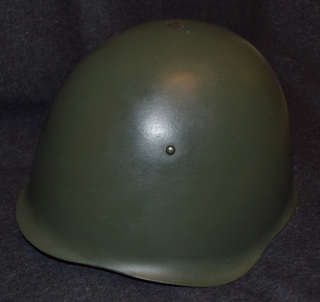
The Wz50 is a steel combat helmet produced in Poland from 1950 to 1955. During the Cold War helmet would be widely exported to a number of Arab countries for its low price.

The Hełm wz. 63 is a Polish steel helmet designed for airborne troops introduced in the 1960s. In the Polish Army, wz. 63 helmet was replaced by the HP-03 helmet in 2015.

The wz. 98 military knife was a fighting knife issued in 1998 to the Polish Armed Forces. It is an improved version of its predecessor – the wz. 92 military knife. All changes that have been made to this knife are dictated by suggestions and comments made by civilian users of the wz. 92 knife, especially those related to survival and scouting.

















